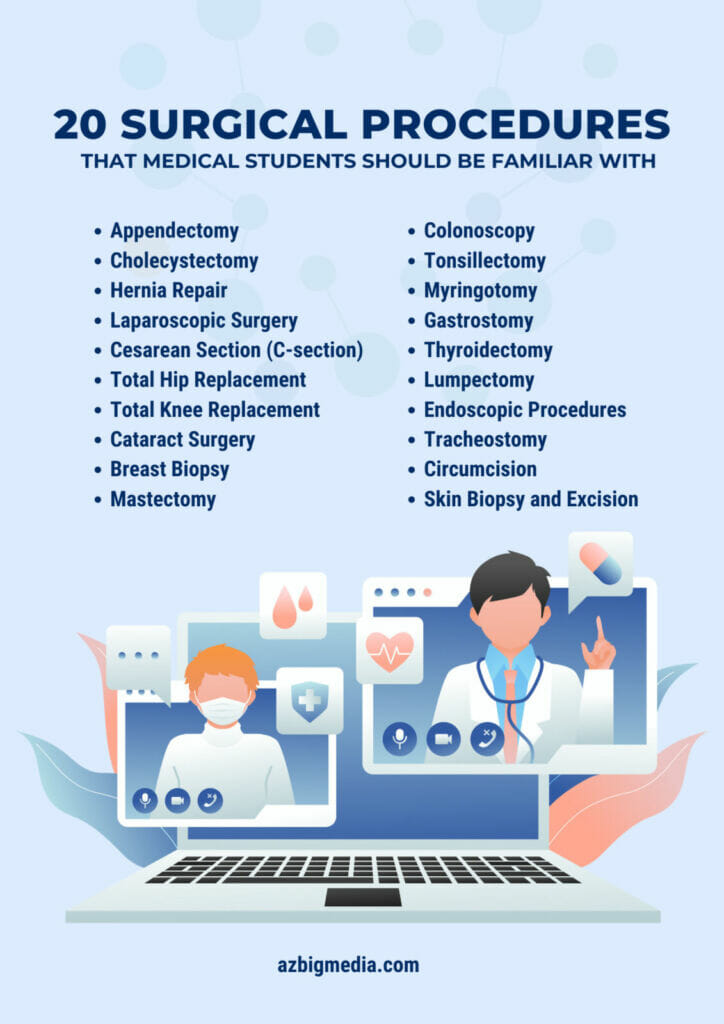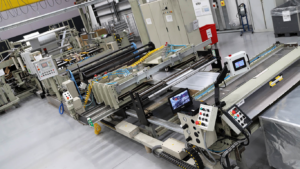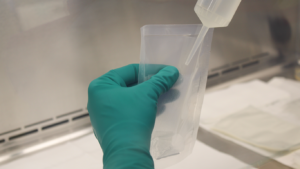As a medical student, expanding your knowledge outside the classroom is crucial for building surgical skills. While nothing replaces hands-on clinical experience, watching lecture videos of key surgeries is invaluable. They allow you to visually learn procedures you may not yet perform yourself.
In this article, you’ll find a list of seven key surgeries every medical student should watch lectures on. Watching these operations performed by experienced surgeons will give you a deeper understanding of common procedures you may observe or assist with during residency and beyond.

#1 Appendectomy
As a medical student, you’ll likely witness or assist with appendectomies during your residency. That’s why it’s crucial to watch surgery lectures online covering this common yet complex procedure. An inflamed appendix can be a surgical emergency, so familiarizing yourself with the intricate steps of an appendectomy before entering the operating room will ensure you can jump in and assist confidently if needed.
Starting with the anatomy
The appendix is a narrow, worm-like tube connected to the cecum, which is the beginning of the large intestine. On average, the appendix is about 3 1⁄2 inches long.
Now the procedure
An appendectomy is done laparoscopically and involves a series of careful steps. First, small incisions are made in the lower right abdomen. The surgeon will insert a laparoscope to see inside and surgical tools to remove the appendix. They’ll cauterize blood vessels connected to it, then detach the organ and pull it through one of the incisions. Finally, the tools get removed, the incisions are closed, and the inflamed appendix is sent for lab testing.
#2 Tonsillectomy
Tonsillectomies are done frequently, so you’ll likely assist in this surgery during your medical training. Watching online lectures will teach you tonsil anatomy and removal methods—key knowledge before stepping into the operating room.
The palatine tonsils are two oval-shaped tissue masses located at the back of the throat. Tonsils play a role in immune system function but can become problematic if enlarged.
There are several techniques to remove the tonsils, and lecturers will often demonstrate these unique approaches. The main methods are
- cold steel dissection using surgical instruments
- electrocautery to dissect and cauterize
- ultrasonic removal using vibrations and
- coblation, which uses radiofrequency energy.
Seeing these techniques used on camera builds familiarity, so you understand the equipment and steps involved no matter the approach.
#3 ACL Reconstruction
The anterior cruciate ligament (ACL) provides stability to the knee joint by connecting the femur to the tibia. ACL tears are common knee injuries, especially in athletes. As an aspiring surgeon, you’ll need to assist with reconstructions.
Watching lecture videos will visually walk through ACL anatomy, common causes of ACL tears, and key steps in the repair procedure. The reconstruction involves taking a tissue graft from another part of the patient’s body or a donor and attaching it in place of the torn ACL.
Lectures show the graft harvesting process from sites like the patellar tendon. You’ll see how drill holes are made through the tibia and femur to thread the new graft through and hold it in place. Then the graft is fixed with screws or buttons.
#4 Bowel Resections
Bowel resections are performed to remove diseased portions of the small or large intestine. Watching online lectures will teach you bowel anatomy and the steps taken to remove damaged sections.
The small intestine includes the duodenum, jejunum, and ileum. The large intestine comprises the cecum, colon, and rectum.
During a bowel resection, the surgeon will make an incision in the abdomen, locate the diseased segment, clamp the bowel on either side and remove that portion. They will then attach the healthy ends back together in anastomosis. This allows digestive continuity to be restored.
The surgery videos will provide an inside look at how the surgeon examines the bowel and identifies regions needing removal. You’ll also see demonstrations of various anastomosis techniques based on the intestinal site.
#5 Cholecystectomy
As a medical student, it’s important to study online lectures outlining the steps of a cholecystectomy. Seeing proper techniques for retracting, controlling bleeders, clipping, and dividing tissue laparoscopically during a cholecystectomy lecture will help prepare you for the OR.
Cholecystectomy is a minimally invasive surgery that removes the gallbladder laparoscopically and is one of the most common operations worldwide. The gallbladder stores and concentrates bile produced by the liver. Bile aids in the digestion of fats. Gallstones and cholecystitis are common gallbladder diseases requiring surgical removal.
In a laparoscopic cholecystectomy, small incisions are made near the navel and lower abdomen. A laparoscope provides visualization as the surgeon removes gallbladder attachments using micro tools. The cystic duct and artery are clipped and divided. After detaching the gallbladder completely, it’s removed through an incision, typically the navel.
#6 Heart Transplant
Heart transplants are awe-inspiring procedures. Although rare, you may get the opportunity to observe one during training. Watching online lectures will make you an informed member of the transplant team when that day comes.
The patient receiving a donor’s heart has end-stage heart failure. After evaluation confirms transplant candidacy, donor-recipient matching occurs based on blood type and organ size.
The patient’s diseased heart is removed in the OR while preserving certain vessels. The donor’s heart is then prepared by trimming it to fit perfectly. After connecting the arteries and veins, the new heart beats once blood flow resumes. The patient is monitored postoperatively for signs of rejection.
Seeing the meticulous, step-by-step process online builds anticipation for potentially witnessing it in person.
#7 Hernia Repair
Abdominal hernias are common conditions you’ll encounter as a surgeon. Watching lectures on hernia repair techniques will prime you to actively assist when the opportunity presents itself.
Hernias involve a protrusion of tissue through a weak spot in the abdominal muscles. Common types are inguinal, incisional, femoral, and umbilical hernias. Symptoms include bulging and pain at the site.
Repairing a hernia involves pushing the protruding tissue back into place and reinforcing the abdomen using surgical mesh. This mesh acts as scaffolding that tissues can grow into, strengthening the area.
Lectures provide an inside view as the surgeon makes the incision, places the mesh, and stitches it into position over the hernia defect. You’ll also learn tips for ensuring proper placement and avoiding complications like recurrence.
Conclusion
Watching online lectures gives invaluable visual familiarity with common surgeries. While medical textbooks provide anatomy foundations, seeing procedures performed on camera builds deeper comprehension. As you prepare for residency and beyond, be proactive by studying these ten key surgeries every medical student should see. Gaining this visual knowledge now allows you to actively participate when the opportunities arise during your training.




